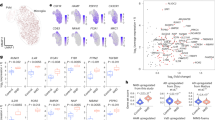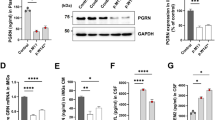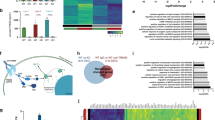Abstract
Nasu-Hakola disease (NHD) is a form of presenile dementia associated with sclerosing leukoencephalopathy and polycystic lipomembranous osteodysplasia. This extremely rare inherited disease is caused by mutations in either DAP12 or TREM2. The present study was designed to assess the relationship between DAP12/TREM2 genotype, mRNA and protein expression levels by both Western blotting and immunohistochemistry, and the tissue distribution and pathomorphological phenotype of the microglia. Molecular genetic testing performed in three NHD cases confirmed that two cases had mutations in DAP12 and that one case carried a mutation in TREM2. Protein levels were analyzed in four cases. Interestingly, significant DAP12 expression was found in numerous microglia in one NHD case with a homozygous DAP12 single-base substitution, and both real-time PCR and Western blotting confirmed the finding. In contrast, levels of both DAP12 and TREM2, respectively, were much lower in the other cases. Immunohistochemistry using established microglial markers revealed consistently mild activation of microglia in the cerebral white matter although there was no or only little expression of DAP12 in three of the NHD cases. The highly different expression of DAP12 represents the first description of such variable expressivity in NHD microglia. It raises important questions regarding the mechanisms underlying dementia and white matter damage in NHD.






Similar content being viewed by others
References
Hakola HPA (1972) Neuropsychiatric and genetic aspects of a new hereditary disease characterized by progressive dementia and lipomembranous polycystic osteodysplasia. Acta Psychiatr Scand 232(suppl):1–17
Nasu T, Tsukahara Y, Terayama K (1973) A lipid metabolic disease—“membranous lipodystrophy”—an autopsy case demonstrating numerous peculiar membrane structures composed of compound lipid in bone and bone marrow and various adipose tissues. Acta Pathol Jpn 23:539–559
Pekkarinen P, Hovatta I, Hakola P, Jarvi O, Kestila M, Lenkkeri U, Adolfsson R, Holmgren G, Nylander PO, Tranebjaerg L et al (1998) Assignment of the locus for PLOSL, a frontal-lobe dementia with bone cysts, to 19q13. Am J Hum Genet 62:362–372
Kaneko M, Sano K, Nakayama J, Amano N (2010) Nasu-Hakola disease: the first case reported by Nasu and review. Neuropathology 30:463–470
Roumier A, Bechade C, Poncer JC, Smalla KH, Tomasello E, Vivier E, Gundelfinger ED, Triller A, Bessis A (2004) Impaired synaptic function in the microglial KARAP/DAP12-deficient mouse. J Neurosci 24:11421–11428
Thrash JC, Torbett BE, Carson MJ (2009) Developmental regulation of TREM2 and DAP12 expression in the murine CNS: implications for Nasu-Hakola disease. Neurochem Res 34:38–45
Graeber MB, Streit WJ (2010) Microglia: biology and pathology. Acta Neuropathol 119:89–105
Kettenmann K, Kirchhoff F, Verkhratsky A (2013) Microglia: new roles for the synaptic stripper. Neuron 77:10–18
Saijo K, Glass CK (2011) Microglial cell origin and phenotypes in health and disease. Nat Rev Immunol 11:775–787
Imai Y, Ibata I, Ito D, Ohsawa K, Kosaka S (1996) A novel gene iba1 in the major histocompatibility complex class III region encoding an EF hand protein expressed in a monocytic lineage. Biochem Biophys Res Commun 224:855–862
Paulus W, Roggendorf W, Kirchner T (1992) Ki-M1P as a marker for microglia and brain macrophages in routinely processed human tissues. Acta Neuropathol 84:538–844
Sasaki A, Nakazato Y (1992) The identity of cells expressing MHC class II antigens in normal and pathological human brain. Neuropathol Appl Neurobiol 18:13–26
Husemann J, Loike JD, Anankov R, Febbraio M, Silverstein SC (2002) Scavenger receptors in neurobiology and neuropathology: their role on microglia and other cells of the nervous system. Glia 40:195–205
Sierra A, Encinas JM, Deudero JJ, Chancey JH, Enikolopov G, Overstreet-Wadiche LS, Tsirka SE, Maletic-Savatic M (2010) Microglia shape adult hippocampal neurogenesis through apoptosis-coupled phagocytosis. Cell Stem Cell 7:483–495
Minagawa M, Maeshiro H, Shioda K, Hirano A (1985) Membranous lipodystrophy (Nasu disease): clinical and neuropathological study of a case. Clin Neuropathol 4:38–45
Kondo T, Takahashi K, Kohara N, Takahashi Y, Hayashi S, Takahashi H, Matsuo H, Yamazaki M, Inoue K, Miyamoto K et al (2002) Heterogeneity of presenile dementia with bone cysts (Nasu-Hakola disease). Neurology 59:1105–1107
Paloneva J, Kestila M, Wu J, Salminen A, Bohling T, Ruotsalainen V, Hakola P, Bakker AB, Phillips JH, Pekkarinen P et al (2000) Loss-of-function mutations in TYROBP (DAP12) result in a presenile dementia with bone cysts. Nat Genet 25:357–361
Numasawa Y, Yamamura C, Ishihara S, Shintani S, Yamazaki M, Tabunoki H, Satoh J-I (2010) Nasu-Hakola disease with a splicing mutation of TREM2 in a Japanese family. Eur J Neurol 18:1179–1183
Konno T, Tada M, Tada M, Koyama A, Nozaki H, Harigaya Y, Nishimiya J, Matsunaga A, Yoshikura N, Ishihara K et al (2013) Haploinsufficiency of CSF-1R and clinicopathologic characterization in patients with HDLS. Neurology 82:139–148
Lanier LL, Corliss B, Wu J, Phillips JH (1998) Association of DAP12 with activating CD94/NKG2C NK cell receptors. Immunity 8:693–701
Humpherey MB, Lanier LL, Nakamura MC (2005) Role of ITAM-containing adapter proteins and their receptors in the immune system and bone. Immunol Rev 208:50–65
Lanier LL, Corliss BC, Wu J, Leong C, Phillips JH (1998) Immunoreceptor DAP12 bearing a tyrosine-based activation motif is involved in activating NK cells. Nature 391:703–707
Kiialainen A, Hovanes K, Paloneva J, Kopra O, Peltonen L (2005) Dap12 and Trem2, molecules involved in innate immunity and neurodegeneration, are co-expressed in the CNS. Neurobiol Dis 18:314–322
Wakselman S, Bechade C, Roomier A, Bernard D, Triller A, Bessis A (2008) Developmental neuronal death in hippocampus requires the microglial CD11b integrin and DAP12 immunoreceptor. J Neurosci 28:8138–8143
Otero K, Turnbull IR, Poliani PL, Vermi W, Cerutti E, Aoshi T, Tassi I, Takai T, Stanley SL, Miller M et al (2009) Macrophage colony-stimulating factor induces the proliferation and survival of macrophages via a pathway involving DAP12 and b-catenin. Nat Immunol 10:734–744
Mehdi H, Ono E, Gupta KC (1990) Initiation of translation at CUG, GUG, and ACG codons in mammalian cells. Gene 91:173–178
Arai H, Miyamoto K, Taketani Y, Yamamoto H, Iemori Y, Morita K et al (1997) A vitamin D receptor gene polymorphism in the translation initiation codon: effect on protein activity and relation to bone mineral density in Japanese women. J Bone Miner Res 12:915–921
Montalbetti L, Ratti MT, Greco B, Aprile C, Moglia A, Soragna D (2005) Neuropsychological tests and functional nuclear neuroimaging provide evidence of subclinical impairment in Nasu-Hakola disease heterozygotes. Funct Neurol 20:71–75
Chouery E, Delague V, Bergougnoux A, Koussa S, Serre JL, Megarbane A (2008) Mutations in TREM2 lead to pure early-onset dementia without bone cysts. Hum Mutat 29:E194–E204
Verloes A, Maguet P, Sadzot B, Vivario M, Thiry A, Franck G (1997) Nasu-Hakola syndrome: polycystic lipomembranous osteodysplasia with sclerosing leucoencephalopathy and presenile dementia. J Med Genet 34:753–757
Paloneva J, Autti T, Raininko R, Partanen J, Salonen O, Puranen M, Hakola P, Haltia M (2001) CNS manifestations of Nasu-Hakola disease: a frontal dementia with bone cysts. Neurology 56:1552–1558
Bianchin MM, Capella HM, Chaves DL, Steindel M, Grisard EC, Ganev GG, da Silva Junior JP, Neto Evaldo S, Poffo MA, Walz R et al (2004) Nasu-Hakola disease (polycystic lipomembranous osteodysplasia with sclerosing leukoencephalopathy-PLOSL): a dementia associated with bone cystic lesions. From clinical to genetic and molecular aspects. Cell Mol Neurobiol 24:1–24
Satoh J, Tabunoki H, Ishida T, Yagishita S, **nai K, Futamura N, Kobayashi M, Toyoshima I, Yoshioka T, Enomoto K et al (2011) Immunohistochemical characterization of microglia in Nasu-Hakola disease brains. Neuropathology 31:363–375
Peri F, Nusslein-Volhard C (2008) Live imaging of neuronal degradation by microglia reveals a role for v0-ATPase a1 in phagosomal fusion in vivo. Cell 133:916–927
Trapp BD, Wujek JR, Criste GA, Jalabi W, Yin X, Kidd GJ et al (2007) Evidence for synaptic strip** by cortical microglia. Glia 55(4):360–368. doi:10.1002/glia.20462
Aoki N, Tsuchiya K, Togo T, Kobayashi Z, Uchikado H, Katsuse O et al (2011) Gray matter lesions in Nasu-Hakola disease: a report on three autopsy cases. Neuropathology 31:135–143
Lue L-F, Schmitz C, Walker DG (2014) What happens to microglial TREM2 in Alzheimer’s disease: immunoregulatory turned into immunopathogenic? Neuroscience. doi:10.1016/j.neuroscience.2014.09.050
Guerreiro (2013) TREM2 variants in Alzheimer’s disease. N Engl J Med 368:117–127
Lue LF, Schmitz CT, Serrano G, Sue LI, Beach TG, Walker DG (2014) TREM2 protein expression changes correlate with Alzheimer’s disease neurodegenerative pathologies in post-mortem temporal cortices. Brain Pathol. doi:10.1111/bpa.12190
Neumann H, Daly MJ (2013) Variant TREM2 as risk factor for Alzheimer’s disease. N Eng J Med 368:182–183
Sierra A, Abiega O, Shahraz A, Neumann H (2013) Janus-faced microglia: beneficial and detrimental consequences of microglial phagocytosis. Front Cell Neurosci 7:6. doi:10.3389/fncel.2013.00006
Kaifu T, Nakahara J, Inui M, Mishima K, Momiyama T, Kaji M et al (2003) Osteopetrosis and thalamic hypomyelinosis with synaptic degeneration in DAP12-deficient mice. J Clin Invest 111:323–332
Parkhurst CN, Yang G, Ninan I, Savas JN, Yates JR III, Lafaille JJ et al (2013) Microglia promote learning dependent synapse formation through brain-derived neurotrophic factor. Cell 155:1596–1609
Kielar C, Wishart TM, Palmer A, Dihanich S, Wong AM, Macauley SL et al (2009) Molecular correlates of axonal and synaptic pathology in mouse models of Batten disease. Hum Mol Genet 18:4066–4408
Giuliano S, Agresta AM, De Palma A, Viglio S, Mauri P, Fumagalli M et al (2014) Proteomic analysis of lymphoblastoid cells from Nasu-Hakola patients: a step forward in our understanding of this neurodegenerative disorder. PLoS One 9, e11073
Chen S-K, Tvrdik P, Peden E, Cho S, Wu S, Spangrude MR (2010) Hematopoietic origin of pathological grooming in Hoxb8 mutant mice. Cell 141:775–785
Naj AC, Jun G, Beecham GW, Wang LS, Vardarajan BN, Buros J et al (2011) Common variants at MS4A4/MS4A6E, CD2AP, CD33 and EPHA1 are associated with late-onset Alzheimer’s disease. Nat Genet 43:436–441
Acknowledgments
The authors would like to thank Drs. T Togo and N Aoki for supplying tissue samples. The expert technical assistance of Tomio Honma and Toshinori Nagai is gratefully acknowledged. This work was supported by a Grant-in-Aid for Scientific Research (C) (25430051) from the Ministry of Education, Culture, Supports, Science and Technology, Japan, and by a Grant-in-Aid from the Research Committee for Hereditary Cerebral Small Vessel Disease and Associated Disorders from the Ministry of Health, Labour and Welfare, Japan.
Ethical approval
This study was conducted with the approval of the Ethical Committees of Niigata University and Saitama Medical University.
Conflict of interest
The authors declare that they have no conflicts of interest.
Author information
Authors and Affiliations
Corresponding author
Electronic supplementary material
Below is the link to the electronic supplementary material.
Supplementary Fig. 1
Microglial morphology and expression of microglial markers in the frontal white matter of NHD brains. In NHD case 1, higher magnification (HE staining) shows enlargement of the perivascular space (a), and immunostaining for CD68 (b), CD163 (c), and CD204 (d) reveals activated and phagocytic microglia, with frequent accumulation of the latter in the perivascular area. In the same case, a cluster of lipid-laden macrophages can be seen in the occipital white matter in the HE stained section (e) and following Iba1 immunohistochemistry (f). Loss of myelin, presence of axonal spheroids (g), and infiltration of microglia and macrophages labeled with antibodies against Iba1 (h) and MHC class II (i) are visible in NHD case 2. Primary magnification: ×20 (PDF 1,457 kb)
Supplementary Fig. 2
Quantification of Iba1-positive cells in the frontal cortex of NHD and control cases. Fourteen microscopic images of Iba1 staining (200× magnification) were acquired in each case from two NHD cases (case 1 and case 2) and two control subjects. Long horizontal lines represent mean values. Morphometric analysis of Iba1-immunostained sections of the NHD cases showed that the percentage (mean ± SD) of tissue area occupied by microglial cell bodies and processes was 8.42 ± 1.747. By contrast, in the control subjects without neurological disease, the average percentage of tissue area occupied by microglial cells was only 2.145 ± 0.56. (PDF 64 kb)
Supplementary Table 1
(PDF 85 kb)
Rights and permissions
About this article
Cite this article
Sasaki, A., Kakita, A., Yoshida, K. et al. Variable expression of microglial DAP12 and TREM2 genes in Nasu-Hakola disease. Neurogenetics 16, 265–276 (2015). https://doi.org/10.1007/s10048-015-0451-3
Received:
Accepted:
Published:
Issue Date:
DOI: https://doi.org/10.1007/s10048-015-0451-3




